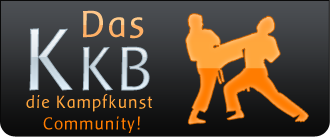Mal ganz interessant zu sehen, was so wo und wann trainiert wurde...
Bruce Lee's Jun Fan Gung Fu Institute Curriculum LA, CA.
The Original Students Training Manual.
Los Angeles, California
By, Sifu Larry Hartsell
The Five Ways Of Attack
SECTION 1
(One) Simple Angle Attack (S.A.A.)
(Check The Eight Basis Blocking Positions)
- Leading With The Right, Guarding With The Left, While Moving To The Right.
- Leading Right Stop Kick (Groin, Knee, Shin)
- Broken Timing Angle Attack (B.T.A.A.)
SECTION 2
(two) Hand immobilizing attack (H.I.A)
(Close Own Boundaries While Closing Distance - Watch Out For Stop Hit Or Kick)
- Ready To Angle Strike When Opponent Opens Or Backs Up
- Use Front Before Immobilize
SECTION 3
(three) Progressive indirect attack (P.I.A.)
Moving Out Of Line Whenever Possible - Boundaries Close Accordingly
1. High To Low
(a) R STR To Low R Thrust
(b) R STR To R Groin Toe Kick
(c) R STR To L STR (Or Kick)
(d) L STR To R Groin Toe Kick
11. Low To High
(a) R STR To High R STR (Or Hook)
(b) R Groin Kick To High R STR
(c) R Groin Kick To High Hook Kick
(d) L STR To R High STR
111. Left/Right Or Right Left
(a) R STR To R Hook
(b) L THR To R STR
(c) Snap Back & L Cross's Opponent's R
(d) Opponent Cross Hand Block (L. Cross)
SECTION 4
(four) Attack by combination (a.b.c)
(Tight Boundaries - Broken Rythm - Surprise Opponent - Speed)
(a) The One-Two (O-N-E- Two)
(b) The O-N-E Two - Hook
(c) R-Body - R-Jaw - L-Jaw
(d) R-Jaw - Hook-Jaw - L-Jaw
(e) The Straight High/Low
SECTION 5
(FIVE) Attack by drawing (A.B.D)
(Awareness - Balance To Attack)
(a) By Exposing
(b) By Forcing
(c) By Feinting
Jun Fan Jeet Kune Do Grappling Arts (Original Bruce Lee's notes)
Do's: 1. Always keep moving. 2. Be prepared for counters. 3. Develop cat-like movements. 4. Make your opponent wrestle your way. 5. Be aggressive; make your opponent think
Don'ts:1. Don't cross your legs. 2. Don't commit your arms to deeply. 3. Don't chase your opponent. 4. Don't rely on one takedown; be ready for other openings. 5. Don't let your opponent circle you..
Joint Locks
Joint Locks may be done while standing or lying on the ground, as an immobilizing technique.
1. Outside armpit lock-to left or right stance.
2. Wrist Lock
3. Reverse Wrist
4. Reverse twisting wrist lock - to double arm lock
5. Lying across arm bar.
6. Standing single leg lock.
7. Lying single leg lock.
8. Single leg and spine lock
9. Double leg and spine lock
10. Foot twist toe.
Chokes:
1. Rear drop choke.
2. Lean over drop choke
3. Side drop choke
Foul Tactics:
1. Hair pulling while in-fighting
.....for control.
2. Foot stomping while in-fighting.
.....for maiming
3. Skin pinching, biting and ear pulling while in-fighting.
.....for release or control
4. Groin grabbing.
.....for maiming or release
Takedown Methods:
1. Circle step single leg tackle.
2. Drop step leg tackle.
3. Draw step leg tackle.
Throwing:
1. Hooking throw.
2. Reverse hooking throw.
3. Single leg tackle and trip.
4. Double leg tackle.
5. Right foot sweep -- with or without arm drag to right or left stance.
6. Left foot sweep -- with or without arm drag to right or left stance.
Closed & Open Bai Jong
All major modes of Jun Fan footwork
Offensive and defensive hand and foot tools, not excluding elbows, knees, forearms, and head.
3 Ranges of Attack
Five and three way kicking drills
Four Corner Lin SIl Die Dar
Extensive Phon Sao
Don Chi Sao
Seong Chi Sao
Inner & Outer Lop Sao Cycle Drills
Woang Pak Drill
Five Way Energy Drill
Free flowing combat sensitivity
Emotional Climate Training
Five Ways of Attack
SDA
ABC
HIA
PIA
ABD
Ground fighting (this is NOT a mat-oriented grappling school or BJJ dojo). The ground is the last place we want to be in a real fight.
Jun Fan/ Jeet Kune Do Kickboxing Drills
Mook Ya Jong
Sparring strategy and application
Sil Lim Tao Form (Complete form as taught by Bruce Lee)
Physical conditioning
Basic Jook Wan
Theories and Principles
Centerline Theory
Mother Line
Economy of Motion Theory
Theory of Facing
The Fighting Measure
Constant Forward Pressure
Four Corner Theory
Primary and Secondary Targets
Defense Zones and Peremeters
Longest Weapon to Nearest Target
Visual Focus Principles
Relax and Explode
Zero Pressure
Non-Intention
Triangle Structure of the Body
Seattle Curriculum
Gin-Lai or Salutation
Bi-jong or ready stance
(Incorporating the Centerline Theory)
Immovable Elbow Theory
Four Corner Theory
Footwork:
Forward
Backward
Shifting right
Shifting left
Sil Lim Tao (basic form taught in Seattle)
Straight punches and elbow punches and various body punches
Bil-jee (finger jab)
Kicks:
Forward straight heel kick
Forward shovel kick
Side kick
Low side kick
Low toe kick
Groin toe kick
Hook kick (medium & high)
Spinning back hook kicks
Chi Sao (sticking hands)
Blocks:
Tan sao
Bong sao
Gong sao
Vertical fist punch
Fook sao or elbow contained bent wrist block
Palm strikes - vertical - side - and palm up
Techniques:
Pak sao
Lop sao
Chop chuie - Gwa chuie
Pak sao lop sao gwa chuie
Lop sao chung chuie lop sao chung chuie
Chop chuie gwa chuie lop sao chung chuie
Oakland Curriculum
Salutation
Kicking Drills:
Five corner kicking: alternating kicks between left and right foot.
Five corner kicking: from low to high.
Clockwork kicking: real-time kicking with the closest weapon.
Combination clockwork kicking & hitting: advanced.
Key: real-time, no hesitation, closest weapon to closest target.
Stance: Bi jong
Lead stance: shuffle, front, rear, side.
Form is the essence, balanced, smooth, feet stay on the ground, (skating)
Strictly lower body movements: each movement is independent.
Comfortable and alive, natural bounce, not rigid or stiff with hops or jumps.
Shuffle to various strikes and kicks.
Key: be alive and comfortable.
Evasive Maneuvers
Evade various strikes (some exaggerated to make easier)
Evade various kicks.
Evade various combinations of strikes and kicks.
Minimal movement to make opponent miss.
Know what position and distance is safe for you.
Individualize and adapt to the size and reach of the opponent.
Evade and counter: after learning the above.
Keys: Better to miss by an inch then to block by a mile.
To block is to get hit.
Don't engage the opponent, disengage him.
(e.g. don't tangle yourself in blocking and trapping movements)
The whole idea is to intercept his physical and emotional intent to hurt you.
Classical versus the New (modern)
Sil lim tao: performed the classical way.
Regarding trapping: cut the movement in half for realism.
Concentrate on speed and economy.
Key: economy of motion, efficiency.
Hook punch: closer to the body then a boxer.
Elbow next to the rib, much tighter and compact.
Key: centerline theory (from the center, not outside or wide).
Take the skin (or paint) off of your ribs.
Rear heel kick: tighter, more centered.
Key: Take the skin (or paint) off the inside of your legs.
Separate punching drills:
Centerline punching (rapid): straight-line blast with closing footwork.
Separate kicking drills
- Two Aspects for improved kicking:
1. Power: Water in the hose analogy for transfer of force through target.
2. Speed: Whip analogy for speed of recovery:
(e.g. shoe laces pop, kicking a gnat out of the air)
Combine, blend power with speed drills, make adjustments.
Keys: Delivery system - instant, fast relaxed.
Hand before foot
Non-telegraphic (no pre-steps or stutter steps)(for punching: no flinching)
Complete emphasis on speed and economy of motion.
The less you move the better.
Clean and sharp as a two edged sword, pure Chinese Kung-Fu.
Power comes with time, sometimes years; on the spot power.
Speed comes with accuracy.
Proper form and body alignment with balance.
Footwork is supposed to be light and easy, not jumping around stiff, but relaxed and smooth without deliberation, angular and instant.
Basic Trapping.
Pak sao
Lop sao
Gong sao
Jut sao
Tan sao
Bong sao
Economy of motion: cut these movements in half.
One hand trap
Two hand trap
Key: Trapping is only a by-product.
Hit, hit and more hit: not trap, trap and then hit.
While engaging an opponent, if there's emptiness…Hit.
Skim and glide with friction but let the Chi flow.
Line drills (Quiet awareness)
Sensitivity: Touch vs. Non-Touch.
Distance: Measure your distance
Safe
No man's land
Gates, body positions, and zones
Key: Put yourself where you're safe and the opponent is not.
Circle to the outside of the strong side, away from rear hand.
Immobilize the lead leg or hand, after you hit, not before.
Practice Drills
Attack and defense.
Key: Stun him first, before obstruction, to break his rhythm or forward momentum.
Apparatus training
Finger jab
Straight blast
Side kick: shin, knee target
Side kick: power through target
Strikes to traps
Kicks to traps
Bridging the gap
Basic wing chun traps
Strike to hand immobilization to takedown
Kick to leg immobilization to takedown
Backfist (high to low, low to high)
Keys: All trapping concludes in hitting
Don't punch and kick at an opponent, kick and punch through him
Broken rhythm (Don't be predictable)
Using the stop-kick as a jab as you incorporate it in footwork
(e.g. be loose, fluid, Ali-like)
1. Burning Step: hand to foot impetus.
2. The pendulum: avoidance then following back swiftly and instantaneously.
3. Basic and primary goal: Each student must find his own
Identifying the tools
Using the tools
Sharpening the tools
Dissolving the tools
In adapting to the opponent:
The Three Phrases:
1. Ice: solid, unchanging, rigid.
2. Water: liquid, flowing.
Steam: gaseous, focused pressure.
Los Angeles Curriculum
Fitness Program
Alternate splits
Waist twisting (three times to each side)
Run in place
Shoulder circling
High kicks
Side kick raise
Sit-ups
Waist twisting
Leg raises
Forward bends
Punching:
(Hanging paper*, glove, glove pad, wall pad, heavy bag)
*Paper Hanging exercise
Bruce taught this exercise for two reasons, control and speed. Tape two wires to a concrete wall. The wires allow you to put an 8 by 11 sheet of paper at different depths towards the wall. The idea was to strike the paper as hard as you could, without moving it. You kept pushing the paper closer and closer until it laid against the wall. You had to hit as hard as you could, without busting your hand up. You became very skilled at depth control. The second exercise was for speed. You hung the paper from two corners, about shoulder high. The idea was to rip the paper with a punch. This required two elements, speed and recoil. It was the recoiling action that tore the paper. This was an important quality for doing concussion punching.
Warm-up - the letting out of water [the idea of dropping the hammer loosely]
The straight punch (left/right) then with pursuing
The entering straight right
high
low
The back fist
Kicking:
Warm-up - (left/right)
letting out of water
the whip
Side kick - (left/right)
[note: choice of group training method]
Facing two lines
In group
One student comes out
Straight kick - (left/right)
Rear kick
The shin/knee/groin kicks
Hook kicks [low first] and toe kick
Combination kicking - eventually with hand
Basic Defense:
The stop hit
The shin/knee kick
The finger jab (close range)
Any type of kick to fit in
The four corner counter
Power training:
Isometric training:
The upward outward force
The basic power training
The punch
The kick
Classical techniques
Pak sao
Lop sao
Gwa chuie
Chop chuie/gwa chuie
Pak sao/gwa chuie
Double lop sao (a & b)
Chop chuie/gwa chuie, lop sao/gwa chuie
Jut sao
Pak sao/jut sao
Chop chuie/gwa chuie/jut tek
Inside gate tan da
Tan da low/gwa chuie
Chop chuie/gwa chuie/lop sao
Combination:
Right hand feint with groin kick
Right kick feint with bil-jee
Right feint to stomach with right straight to head
Right feint to head shift to right to stomach.





